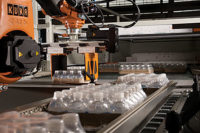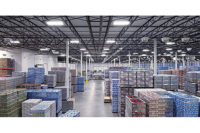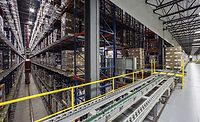Warehouse management systems offer efficient distribution
Automated management allows for better visibility, optimized processing

American retailer Build-A-Bear Workshop Inc. has made millions by allowing children to create their new best friend in-store. However, the fun, frivolity of kids “stuffing” their fuzzy companions sometimes can result in toys that are busting at the seams. Luckily, this type of problem can easily be fixed with a needle and thread. But in a beverage warehouse, a facility that’s busting at the seams with SKUs needs more than amateur sewing knowledge to solve its problems.
|
“SKU proliferation has affected the beverage industry in much the same way that it’s affected the retail sector,” says Gene Billings, director of software products for Cincinnati-based Intelligrated. “This product expansion requires better management of warehouse, slotting [and] product movement from receiving to picking through shipping. With the increases in SKUs, better visibility into trends such as seasonality and how that will affect the efficiency of fulfillment and overall storage needs becomes greatly important. Along with the requirement of tightening up warehouses’ storage, SKU expansion also brings with it the need to further optimize order fulfillment processes since more touches are required.”
As warehouses look to optimize their operations, many are turning to software applications for solutions such as warehouse management software (WMS) or warehouse control software (WCS).
“Wholesalers are utilizing WMS/WCS applications in the beverage industry to help them move product more quickly and efficiently, reduce their inventory levels, and increase their order fulfillment accuracy,” says Dave Williams, director of software development for Westfalia Technologies Inc., York, Pa.
Lennard Koppelmann, director of the IT and automated systems division for Charlotte, N.C.-based Schaefer Systems International Inc. (SSI), notes that WMS systems can provide increased transparency across warehouse operations.
“From receiving to shipping, all products can be tracked by vendor/manufacturer, lot number, best-before date, etc.,” he says. “Inventory segregation enables the wholesaler to maintain different ‘owners’ for the product, which can then be taken into consideration for order fulfillment as well.”
By having this type of organization, companies can implement practices like first in, first out as well as create safeguards to ensure that customer orders will be filled properly and timely, says John Barry, vice president of sales and marketing for the Americas for ITW Warehouse Automation (ITWWA), Arden, N.C.
“The real benefit is you just become more efficient and you’re really able to direct commands in a more organized and efficient [manner],” he says.
Application levels
Once a distributor has determined that it wants to implement software controls for its storage and picking operations, it then is tasked with deciding what level of software is suitable for its business.
For example, a cloud-based WMS can be ideal for distributors that have experienced fast growth or seasonal spikes, says Chuck Fuerst, director of product strategy for HighJump Software, Minneapolis.
“When a vendor hosts the application offsite, installation of the system is much faster, and it frees up a company’s IT team to focus on customer-facing applications rather than infrastructure software,” he says. “In addition, a company can access more power or dial it down based on its sales spikes and valleys. In short, cloud-based WMS/WCS are an extremely elastic and efficient approach for a beverage company.”
Outlook plans for size and automation also can be an important factor when determining what type of software systems to employ.
“As a distributor, you need to determine how to forecast the size your operations are going to be,” says Markus Schmidt, senior vice president of U.S. operations for Swisslog, Newport News, Va. “After you have done that, you might want to consider one level of mechanization or automation that you want to deploy [for] that size.”
Bill Leber, business development manager for warehouse and distribution solutions for Swisslog, notes that no matter what size of operation a company is running, it needs to have some rudimentary WMS for working in the beverage industry. However, if the warehouse contains more advanced automation capabilities, a WCS will interface between orders and inventory and communicate that to the machinery, such as automated storage and retrieval systems, sorting systems, conveyors and more.
Echoing similar thoughts, Intelligrated’s Billings says that the WCS will orchestrate the automation equipment to get the most out of a hardware investment. “A robust WCS should be able to recognize opportunities in the order-fulfillment process to insert pick tasks in real-time in order to remove unnecessary gaps in the picking process,” he says.
Westfalia’s Williams emphasizes that when working with automation, it is important that WMS and WCS systems are working synergistically.
“A warehouse where automation is present requires the use of a WCS that is designed with automation in mind,” he says. “It is also important that the WMS and the WCS are tightly coupled in an automated facility. If they are not, then product auditability/traceability can be compromised.”
Westfalia’s Savanna.Net is a flexible, modular WMS and a fully integrated WCS that is based on Microsoft C#.Net technology, Williams says.
He adds that it is important for companies to do their “homework” when selecting a WMS or WCS and that bigger isn’t always better. “You need to work with a company that you can trust and that understands the nuances of your business,” he says.
SSI’s Koppelmann adds that whether large or small, scaling a software system to fit your operations is a key component.
“For any warehouse operation, it is important that the WMS solution scales to size both from a functional as well as cost standpoint,” he says. “Traditional WMS solutions may not always be cost efficient for smaller operations because many of the features that come with standard WMS packages may not be needed. Especially for smaller operations, a lightweight WMS solution that supports all basic warehouse processes is required. This will enable the warehouse to utilize the WMS solution a lot quicker and with a steeper ramp-up curve.”
Automated future
Due to a number of factors impacting the beverage industry, suppliers foresee automation playing a bigger role in warehouse operations and see software systems as a solution to handling that transition.
“As real estate costs skyrocket, the need to store more products in a smaller footprint will continue to drive companies to look for alternatives like deep storage,” Westfalia’s Williams says. “The ability to manage inventory levels more closely and the need to provide unparalleled solutions for product traceability will require the beverage industry to further look to automation and WMS/WCS applications to manage their distribution.”
Swisslog’s Leber echoes similar sentiments: “If you look at longer-term trends, [WCS] is going to be a good fit, we believe, for higher levels of automation, because of a couple of things, in that energy costs and SKU proliferation are kind of driving the efficiencies toward putting more and more distribution systems close to customers in urban areas, and that’s where you run into cost concerns. People want to retrofit [and] better densify.”
By making warehouses denser, higher forms of automation will become necessary and require the software to support the more mechanized operations, he adds.
Looking for a reprint of this article?
From high-res PDFs to custom plaques, order your copy today!









